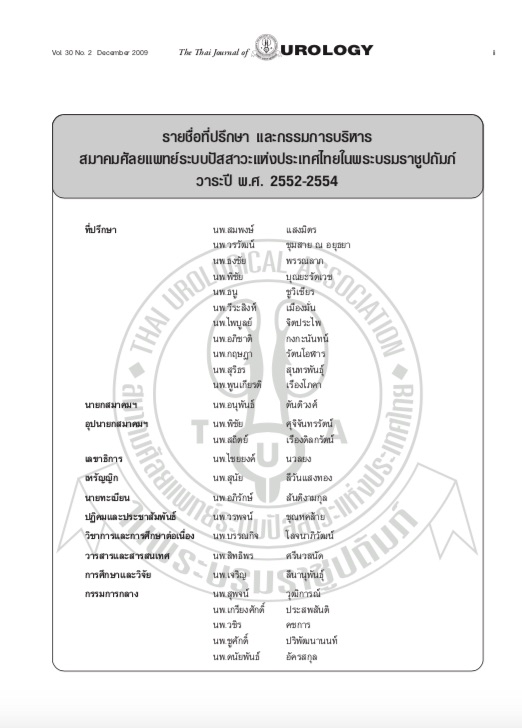Pathologic Diagnosis of Prostatic Adenocarcinoma
Keywords:
Pathologic, Diagnosis, Prostatic, AdenocarcinomaAbstract
Prostatic adenocarcinoma is the most common malignancy in men in the United States and is the second most common cause of cancer death following lung cancer.[1] It was estimated that approximately 28,660 American men died of this tumor in 2008, while 186,320 new cases were detected.[2] In Thailand, it is among the three most common malignancies in male with an estimated incidence rate as high as 4.9 per 100,000.[3] It is now the most common cancer in men in Siriraj Hos-pital.[4] Latent prostate cancer incidentally found at the time of autopsy is also high, up to 80 % by age 80 years.[5]
Pathologically, the diagnosis of prostatic adenocarcinoma requires a combination of architectural, cytologic, and ancillary findings.[1,6] In the past, the prostate was divided into 5 lobes namely, anterior, middle, posterior, and 2 lateral lobes.[7] In 1988 McNeal introduced a different anatomic division. He devided the prostate into zones, namely peripheral zone (TZ), central zone and transition zone,[8] which was subsequently globally accepted since this zoning correlated better with the deseases of the prostate. The peripheral zone accounts approximately for 65% of normal prostatic volume and is prone to the development of inflammation and adenocar-cinoma,[9,10] while transition zone is responsible for the development of benign prostatic hyperplasia (nodular hyperplasia).[11]
References
Kumar V, Abbas A, Fausto N. editors. Robbins and Cotran pathologic basic of disease. 7th ed. Epstein JI, editor. Philadelphia: Elsevier sSaunders: 2005, 1050.
Jemal A,Siegel R, Ward E, et al. Cancer statistics, 2008. CA Cancer J Clin 2008; 58:71-96.
Sriplung H, Sontipong S, Martin N, et al. (Department of Medical Service, National Cancer Institute, Ministry of Public Health, Thailand). Cancer in Thailand 2003; 3:1995-1997, 53-5.
Ratanawichitrasin A. editor. Annual report of tumor registry in Siriraj cancer center Siriraj Hospital, Bangkok, 2007; 4-5.
Bostwick DG, Cooner WH, Denis L, et al. The association of benign prostatic hyperplasia and cancer of the prostate. Cancer 1992; 70: 291-301.
Humphrey PA. Diagnosis of adenocarcinoma in prostate needle biopsy. J Clin Pathol 2007; 60: 35-42.
Lowsley OS. The development of the human prostate with references to the development of other structures of the neck of the urinary bladder. Am J Anat 1912; 13: 299-349.
McNeal JE. Normal histology of the prostate. Am J Surg Pathol 1988; 12: 619-33.
McNeal JE. Origin and development of carcinoma in the prostate. Cancer 1969; 23: 24-34.
McNeal JE, Redwine EA, Freiha FS. et al. Zonal distribution of prostatic adenocarcinoma. Correlation with histologic pattern and dissection of spread. Am J Surg Pathol 1988; 12: 897-906.
McNeal JE. Origin and evolution of benign prostatic enlargement. Inrest Urol 1978; 15: 340-5.
Epstein JI, Yang XJ. Prostate Biopsy Interpretation. Philadelphia: Lippincott, Williams & Wilkins, 2002.
Young RU, Srigley JR, Amin MB, Ulbaight TM, Cubilla AL. Atlas of Tumor Pathology. Tumors of the Prostate Gland. Seminal Vesicles, Male Urethra, and Penis. Washington DC: Armed Forces Institute of Pathology, 2000.
Epstein JI, Allsbrook WC, Amin MB, Egevad LL, and The ISUP Grading committee. The 2005 international society of urological pathology (ISUP) consensus conference on Gleason grading of prostate carcinoma. Am J Surg Pathol 2005; 29: 1228-42.
Bostwich DG, Editor. Pathology of the Prostate. New York: Churchill Livingstone; 1990 (Gleason DF, editor. Histologic Grading of Prostatic Carcinoma).
Bostwick DG, Brawer MK. Prostatic intra-eptthelial neoplasic and early invasion in prostate cancer. Cancer 1987; 59: 788-94.
Bostwick DG, Eble JN. Editors. Urological Surgical Pathology. St Louis: Mosby, 1997. Chapter 7. Neoplasms of the prostate.
Baisden BL, Kahane H, Epstein JI. Perineural invasion,mucinous fibroplasias, and glomerulation: diagnostic features of limited cancer on prostatic needle biopsy. Am J Surg Pathol 1999, 19: 1068-76.
Jacob S, Mammen K. Collagenous micronodules in prostatic adenocarcinoma: a case report. Indian J Pathol Microbiol 2004, 47: 406-7.
Noiwan S, Ratanarapee S. Mucin production in prostatic adenocarcinoma: A retrospective study of 190 radical prostatectomy and /or core biopsy specimens in Department of Pathology, Siriraj Hospital, Mahidol University. J Med Assoc Thai (in press).
Boonlorm N, Ratanarapee S. Mucin production in prostatic adenocarcinoma: A retrospective study of 51 radical prostatectomy specimens in Thai population. Siriraj Med J (in press)
Bostwick DG, Meiers I. Diagnosis of prostatic carcinoma after therapy. Review Arch Pathol Lab Med 2007; 131: 360-71.
Patraki CD, Sfikas CP. Histopathological changes induced by therapies in the benign prostate and prostate adenocarcinoma. Histol Histopathol 2007; 22: 107-18.
Rapkiewicz A, Gorokhovsky R, Farcon E, DasK. Cytology of metastatic prostatic cancer following orchiectomy and antiandrogen therapy: a diagnostic challenge. Cytopathol 2008; 36: 499-502.



